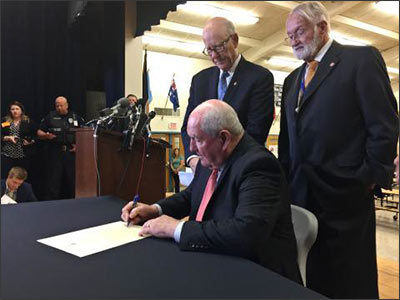Ag Secretary Moves to Provide
Nutrition Flexibility for School Meals
Perdue gives more local control of whole grains, sodium and milk to make meals healthful and appealing.

Secretary of Agriculture Sonny Perdue eats lunch with students at Catoctin Elementary School.
U.S. Secretary of Agriculture Sonny Perdue May 1 announced that the USDA will provide greater flexibility in nutrition requirements for school meal programs in order to make food choices both healthful and appealing to students. Perdue made the announcement during a visit to Catoctin Elementary School in Leesburg, Va., to mark School Nutrition Employee Week.
Perdue signed a proclamation that begins the process of restoring local control of guidelines on whole grains, sodium and milk. Perdue was joined by Kansas Senator Pat Roberts, chairman of the Senate Committee on Agriculture, Nutrition and Forestry, and Patricia Montague, CEO of the School Nutrition Association.
“This announcement is the result of years of feedback from students, schools and foodservice experts about the challenges they are facing in meeting the final regulations for school meals,” Perdue said. “If kids aren’t eating the food and it’s ending up in the trash, they aren’t getting any nutrition — thus undermining the intent of the program.”
“I commend Secretary Perdue for taking this important step,” said Montague. “We have been wanting flexibility, so that schools can serve meals that are both nutritious and palatable. We don’t want kids wasting their meals by throwing them away. Some of our schools are actually using that food waste as compost. That shouldn’t be happening.”
Schools have been facing increasing fiscal burdens as they attempt to adhere to existing, stringent nutrition requirements. According to USDA figures, school food requirements cost school districts and states an additional $1.22 billion in fiscal year 2015. At the same time costs are going up, most states are reporting that they’ve seen a decrease in student participation in school lunches, as nationwide about 1 million students choose not to have a school lunch each day. This impacts schools in two ways: The decline in school lunch participation means reduced revenue to schools while they simultaneously are encountering increased costs.
“I was talking to some folks in Washington about this, and they said that the current program is working. ‘How do you know?’ I asked. They said it’s because 99% of schools are at least partially compliant. Well, only in Washington can that be considered proof that the system is working as it was intended,” Perdue said. “A perfect example is in the South, where the schools want to serve grits; but the whole-grain variety has little black flakes in it, and the kids won’t eat it. The school is compliant with the whole-grain requirements, but no one is eating the grits. That doesn’t make any sense.”
The specific flexibilities are:
- Whole grains
- Schools are experiencing challenges in finding the full range of products they need and that their students enjoy in whole-grain-rich form. They need continued flexibility in meeting the whole-grain requirements for school meals.
- USDA will allow states to grant exemptions to schools experiencing hardship in serving 100% of grain products as whole-grain-rich for school year 2017-2018. USDA will take all necessary regulatory actions to implement a long-term solution.
- Sodium
- For school years 2017-2018 through 2020, schools will not be required to meet Sodium Target 2. Instead, schools that meet Sodium Target 1 will be considered compliant.
- The time frame will provide schools and the school nutrition industry with the certainty and predictability they need to make appropriate plans for creating foods with the appropriate amount of sodium. During this period, USDA will take all necessary regulatory actions to implement a long-term solution.
- USDA will dedicate significant resources to providing technical assistance to schools as they continue to develop menus that are low in sodium and appealing to students.
- Milk
- Milk is a key component of school meals, meaning schools must have more options for students who select milk as part of their lunch or breakfast.
- Perdue will direct USDA to begin the regulatory process for schools to serve 1% flavored milk through the school meals programs. USDA will seek to publish an interim rule as soon as possible to effect the change in milk policy.
“I’ve got 14 grandchildren, and there is no way that I would propose something if I didn’t think it was good, healthful and the right thing to do,” Perdue said. “Here’s the thing about local control: it means that this new flexibility will give schools and states the option of doing what we’re laying out here today. These are not mandates on schools.”
Perdue lauded the efforts of the nation’s foodservice staff in serving healthful, appealing meals and underscored USDA’s commitment to help them overcome any remaining challenges they face in meeting the nutrition standards.

Perdue, joined by Sen. Pat Roberts (left) and Tom Marshall, Loudoun County School Board, signs a proclamation.
“The hard work and dedication of the people who prepare nutritious meals for our children should serve as an example to all, and we will continue to support them,” Perdue said. “We also have a responsibility to our shareholders and our customers — the American taxpayers — to provide our school children with healthful and nutritious meals in the most efficient and cost-effective way possible.”
For more information, please view a copy of Perdue’s proclamation online.
USDA’s Food and Nutrition Service administers 15 nutrition assistance programs that include the National School Lunch Program, School Breakfast Program, Supplemental Nutrition Assistance Program (SNAP), Special Supplemental Nutrition Program for Women, Infants and Children (WIC), and the Summer Food Service Program. Together, these programs comprise America’s nutrition safety net. For more information, visit www.fns.usda.gov.

Editor’s Note: This article is provided by the USDA.






